Cornhill, Boston

Cornhill, Boston, 1962
Cornhill was a street in Boston, Massachusetts, in the 19th and 20th centuries, located on the site of the current City Hall Plaza in Government Center. It was named in 1829; previously it was known as Market Street (1807-1828).[1][2] In its time, it comprised a busy part of the city near Brattle Street, Court Street and Scollay Square. In the 19th century, it was the home of many bookstores and publishing companies.[3] As of 1969, Cornhill exists as 144 feet along the edge of City Hall Plaza.[4]
See also
- City Hall Plaza
- Sears' Crescent building (built 1816) 100 City Hall Plaza; formerly 38-68 Cornhill)[5][6]
- Sears' Block (built 1848) corner Court + Washington St., formerly 70-72 Cornhill[5][6]
- Previous tenants of Cornhill
- Annin & Smith, 19th-century engravers[7]
- Iver Johnson Sporting Goods Company, Located in the Iver Johnson Building, corner of Washington Street and Cornhill
- Daniel Clement Colesworthy, bookseller, c. 1850s[8]
- Frost & Adams, art supplies
- The Liberator (anti-slavery newspaper), published by Isaac Knapp, Cornhill, c. 1837[9]
- Bela Marsh, 19th century publisher
- F.T. Somerby, painter
Images
 Detail of 1826 map of Boston, showing Market Street (renamed Cornhill in 1828)
Detail of 1826 map of Boston, showing Market Street (renamed Cornhill in 1828)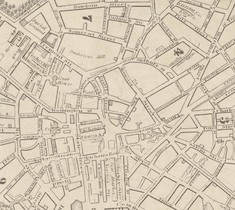 Detail of 1832 map of Boston, showing Cornhill and vicinity
Detail of 1832 map of Boston, showing Cornhill and vicinity Cornhill, c. 1836. Shows shops of Light & Horton; Gerry & Burt; George W. Light; Peck & Co.; William Peirce; etc.
Cornhill, c. 1836. Shows shops of Light & Horton; Gerry & Burt; George W. Light; Peck & Co.; William Peirce; etc. Advertising for the Prisoner's Friend published on Cornhill, c. 1840s. "Devoted to the abolition of capitol punishment, and the improvement of prison discipline"
Advertising for the Prisoner's Friend published on Cornhill, c. 1840s. "Devoted to the abolition of capitol punishment, and the improvement of prison discipline"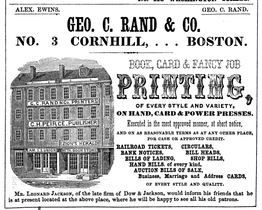 Advertisement for George C. Rand & Co. printers, 1849
Advertisement for George C. Rand & Co. printers, 1849 Advertisement for Stephen Smith's Desk Warehouse, 1854
Advertisement for Stephen Smith's Desk Warehouse, 1854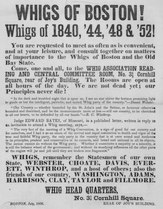 Whig Headquarters, 1856
Whig Headquarters, 1856 Ad for James Campbell, antiquarian bookshop, c. 1860s[10]
Ad for James Campbell, antiquarian bookshop, c. 1860s[10]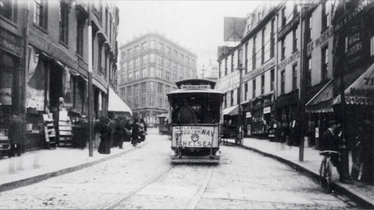 c. 1897
c. 1897 Cornhill, Boston, c. 1905
Cornhill, Boston, c. 1905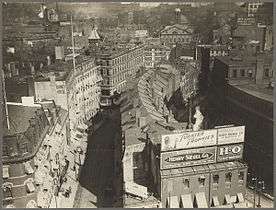 Overview of Brattle St. (left), Cornhill (right), and Faneuil Hall (upper right), c. 1920
Overview of Brattle St. (left), Cornhill (right), and Faneuil Hall (upper right), c. 1920
References
- ↑ Edward Hartwell Savage (1886), Boston events, Boston: Mutual News Co.
- ↑ From 1708 to 1824, a portion of Washington Street was known as "Cornhill;" cf. Boston (Mass.). Street laying-out Dept. (1910), A record of the streets, alleys, places, etc. in the city of Boston (2 ed.), Boston: City of Boston Printing Dept.
- ↑ "Cornhill – Once Boston’s Literary Center, Today Replaced by Government Center". Forgotten New England. Retrieved 10 May 2016.
- ↑ "Public way. Open from Franklin Ave to approximately 144 feet easterly." cf. "Street Book". City of Boston. Retrieved 2010-06-17.
- 1 2 "National Register of Historic Places". U.S. Dept. of the Interior. Retrieved 2010-06-17.
- 1 2 Susan Southworth; Michael Southworth (2008), AIA guide to Boston (3 ed.), Guilford, Conn: Globe Pequot, OCLC 175057014
- ↑ Boston Directory. 1832
- ↑ Boston Directory. 1857
- ↑ American Broadsides and Ephemera, Series 1, no. 5153
- ↑ Boston Directory. 1861
Further reading
- "Old Boston Booksellers: the Three Burnham Brothers and their Antecedents." New York Times, July 21, 1893. (Mentions Samuel B. Drake and Burnham Brothers, booksellers).
External links
| Wikimedia Commons has media related to Cornhill (Boston, Massachusetts). |
- Bostonian Society has materials related to the street.
- G.Kepes. Photo of Scollay Square From Pemberton Square Looking Across to Cornhill Street, 1957.
- Flickr. Sears Crescent, 1999
- Flickr. Sears Crescent, 2008
- Flickr. Photo, 2009
Coordinates: 42°21′34.58″N 71°3′27.81″W / 42.3596056°N 71.0577250°W
This article is issued from
Wikipedia.
The text is licensed under Creative Commons - Attribution - Sharealike.
Additional terms may apply for the media files.